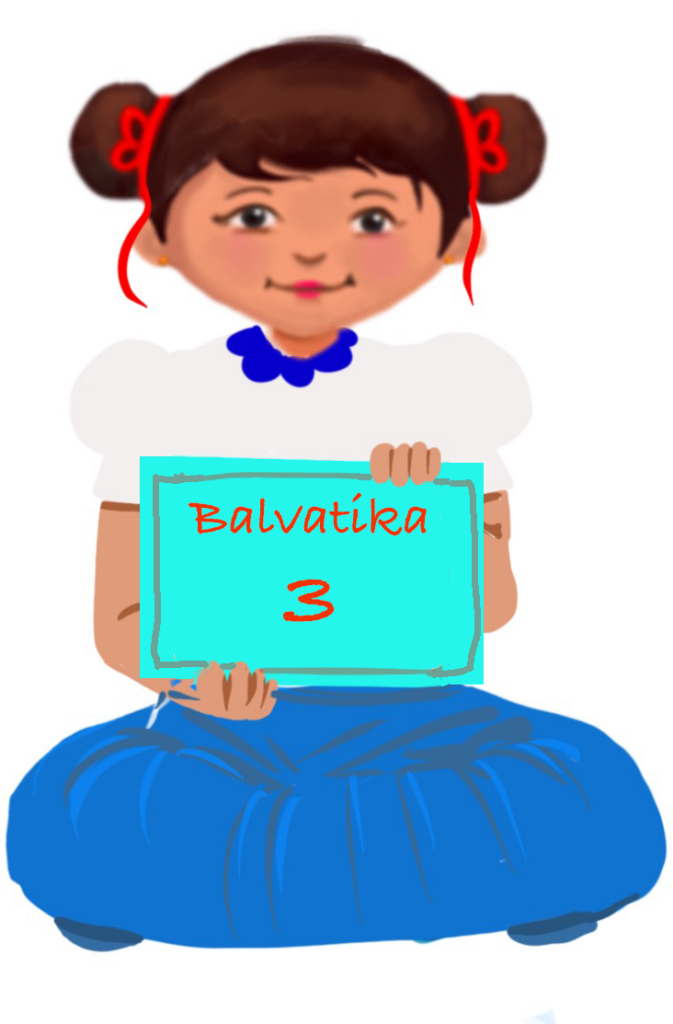
Numbers 1 to 10
Week 3 – Reading and writing numbers from 1 to 10
Learning Outcome
Recognises, reads and writes numbers from 1 to 10.
 Objective
Objective
Children will be able to read and write the numbers from 1 to 10.
 Prerequisites
Prerequisites
Pre-number skills such as one-to-one correspondence, memory skills, matching, and reading numbers 1 to 10.
Introduction
- The teacher can begin the class by giving a revision of counting numbers. For this, the teacher can put some coloured balls in a basket and flash cards showing numbers 1 to 10 on the table.
- The teacher can show a flashcard and ask a child to count the corresponding number of balls and keep them on the basket kept on the table.
- The teacher then begins with strokes. For this, she should write the following symbols one by one, reciting the same. Standing line, sleeping line, slanting line, right curve, left curve, and an ’O’ circle.
- After familiarising the children with the symbols, the teacher can start writing the numbers on the blackboard. She can write 1 on the blackboard, saying, “A standing line makes 1,” “a right curve and a sleeping line makes 2,” “two right curves make 3,” etc. During this, she can encourage the children to trace the numbers in the air. Slowly, the teacher can introduce all the numbers from 1 to 10 in a similar manner. The teacher can also sing the strokes in a rhythmic way to keep the children engaged, like, “A slanting line and a sleeping line and again a standing line make the number four.”
- After the introduction, she can do the following activities with children to help the children in their practice.
- The teacher can use the following activities to reinforce the symbols.
- By Air Drawing: Trace the stroke symbols in air with fingers and recite the name of each while doing so.
- By using shaving foam.
Resources required:
- Coloured Balls
- A basket
- Flashcards showing numbers 1 to 10.
Refer to ‘Number sense’ Adaptations and Strategies given in the Main page of ‘Numbers 1 to 10’ if there are any neuro-diverse children in the class.
Video: Tracing numbers
ISL Video: Tracing numbers
Video: Writing numbers
Activity 1: Tracing on Sand
Objective: To trace numbers from 1 to 10.
Importance of the activity for children:
Helps in developing:
- Gross motor skills (moving around, bending)
- Fine motor skills (tracing)
- Cognitive skills (focus, visual perception)
- Problem solving (follow a sequence of steps)
- Social skills (playing together, encouraging other children)
- Communication skills (discussions among the children and with teacher)
Resources required:
1. A Tray
2. Sand / Rice
3. Sand paper cut-outs
Setting for the activity:
The activity can be done indoors or outdoors, depending on the availability of space.
Type of activity: Individual activity
Preparation of activity:
- The teacher should get the tray and the sand/rice ready in front of the children.
- The teacher can use the cut-outs of sandpaper.
Role of the teacher: Demonstrator and facilitator
Procedure:
- The teacher should fill the tray with sand or rice, whichever is available.
- The teacher can make each child trace the numbers from 1 to 10 in the tray filled with sand or rice.
Suggested variations in rules:
- Hide small objects (e.g., beads, shells) under the sand. Once the child finishes tracing a number, they can “dig up” a hidden treasure, adding a fun element.
- The activity can be a time challenge where the child traces numbers from 1 to 10 in sequence as quickly as possible.
Conclusion:
Children will learn to trace the numbers from 1 to 10.
Video: Tracing on sand
ISL Video: Tracing on sand
LTM Video: DIY – Sandpaper numbers
Activity 2: Hoppity Hop
Objective:
To practise tracing numbers from 1 to 10.
Importance of the activity for children:
Helps in developing:
- Gross motor skills (moving around, walking)
- Fine motor skills (tracing through leg movements)
- Cognitive skills (focus, visual perception)
- Problem solving (follow a sequence of steps)
- Social skills (playing together, encouraging other children)
- Communication skills (discussions among the children and with teacher)
Resources required:
- Cut out of numbers
- Adhesive tape
Setting for the activity:
The activity can be done indoors or outdoors, depending on the availability of space.
Type of activity: Group activity
Preparation of activity:
The teacher should paste the numbers from 1 to 10 using adhesive tape on the floor or use chalk to draw.
Role of the teacher: Demonstrator and facilitator
Procedure:
- Paste the numbers from 1 to 10 using adhesive tape on the floor.
- The children should hop over or walk over one number after the other.
Observation:
The children can trace the numbers from 1 to 10.
Suggested variations in rules:
As children hop on each number, they must say it out loud and then call out a word that rhymes with the number. For example – one and sun
Conclusion:
The children will learn to trace the numbers from 1 to 10 by walking on the image.
Video: Hoppity hop
ISL Video: Hoppity hop
Activity 3: Guess the Numbers
Objective: To practice tracing numbers from 1 to 10.
Importance of the activity for children:
Helps in developing:
- Gross motor skills (moving around, walking)
- Fine motor skills (tracing through leg movements)
- Cognitive skills (focus, visual perception)
- Problem solving (follow a sequence of steps)
- Social skills (playing together, encouraging other children)
- Communication skills (discussions among the children and with teacher)
Setting for the activity:
The activity can be done indoors or outdoors, depending on the availability of space.
Type of activity: Group activity
Preparation of activity:
The teacher should divide the children into groups of 2.
Role of the teacher: Demonstrator and facilitator.
Procedure:
- The teacher should call one pair at a time to the front.
- The teacher will whisper a number in the ears of one child of the pair.
- The other child will close his / her eyes, while the first child will trace the number mentioned by the teacher on the other child’s hands.
- The child who closed his/her eyes should guess this number.
- The teacher can repeat by whispering a number to the other child so that each child gets a chance to trace and guess.
- Repeat the same for all groups.
Observation:
The children can trace the numbers from 1 to 10.
Suggested variations in rules:
- Both children trace the same number simultaneously—one on the partner’s hand and one in the air.
- Instead of tracing numbers on the hand, the first child can trace the number on the back of the second child using his/her finger.
Conclusion:
The children will learn to trace the numbers from 1 to 10.
Refer to ‘Visuospatial skills’ Adaptations and Strategies given in the Main page of ‘Numbers 1 to 10’ if there are any neuro-diverse children in the class.
Video: Guess the number
ISL Video: Guess the number
Assessment
The teacher can give the practice worksheet to the children that can be followed by assessment worksheet.
Practice Worksheet: Write the numbers
Practice Worksheet: Write the numbers (Enlarged)
Assessment Worksheet: Fill in the blanks
Assessment Worksheet: Fill in the blanks (Enlarged)
Check list for teacher:
| Activity | Yes | No | Sometimes |
| Children can: | |||
| Read and write the numbers from 1 to 10 | |||
| Trace numbers from 1 to 10 on sand or sand paper cut outs | |||
| Figure out how to complete the task of tracing | |||
| Recognise the tracing and guess the number | |||
| Focus on the activity | |||
| Complete the activity in the given time | |||
| Do the activity independently | |||
| Express verbally and through actions, expressions or gestures |
Teacher Resource Document
| Source and Attribution of images: All images used in the above Assets and Aids are originally created. |
| This digital material has been developed by the Sri Sathya Sai Vidya Vahini Inclusive Education Project, a unit of Sri Sathya Sai Central Trust, Prasanthi Nilayam, as a collaborative offering in the service of our nation. |